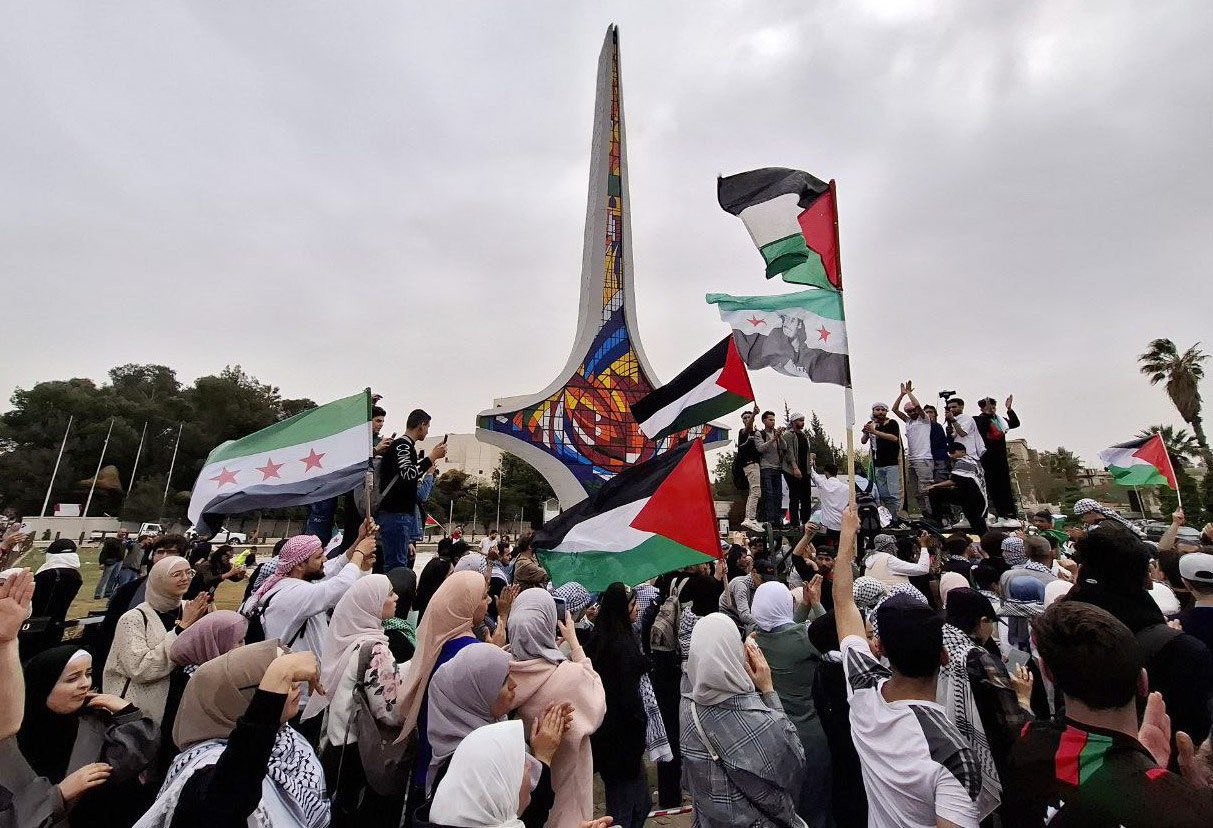
by JURIST Staff
We may not have the infrastructure, but we have the will.
—Banner held at protests across Syria, April 2025
In an unprecedented wave of demonstrations across government-held territory, the Syrian people have taken to the streets not to challenge their own leadership, but to protest Israel’s ongoing human rights atrocities in Gaza and its repeated military strikes on Syrian soil.
This explainer breaks down what’s happening, what’s fueling the anger, and what it signals about a country emerging from decades of harsh internal rule, and why Syrians are rallying around a cause that reaches well beyond their own country’s borders.
What’s going on?
Throughout early April, mass demonstrations repeatedly erupted in Damascus, Daraa, Sweida, Hama, Tartus and other cities across Syria. According to reports from the official Syrian Arab News Agency (SANA), these protests were organized in solidarity with the Gazans—who have endured over a year and a half of devastating Israeli bombardment—and in condemnation of repeated Israeli attacks inside Syria, including deadly air-strikes.
The largest of the demonstrations were held in the country’s capital Damascus, where crowds raised Syrian and Palestinian flags and called for an end to what they are calling a genocide in Gaza.
What triggered the protests?
The immediate catalyst was a deadly Israeli air-strike on April 2 that targeted al-Jubailiya Dam forested area in Daraa governorate’s western countryside, killing nine civilians. It was one of five air-strikes launched in a single evening, which also resulted in the near-total destruction of Hama Military Airport.
However, collective outrage had been brewing long before the April 2 air-strike. Since October 2023, Israel has conducted near-daily air raids across Syria — actions which Damascus residents say have killed civilians, destroyed military infrastructure, and obstructed post-war recovery efforts.
On top of that, Israel’s March 18 withdrawal from a ceasefire and prisoner exchange deal in Gaza reignited outrage. The cumulative death toll in the Gaza Strip, as reported by the Gaza Ministry of Health, now exceeds 50,810 dead and 115,688 wounded.
Is this linked to Syria’s internal politics?
Yes, but not in the way we’ve seen before. These protests are not targeting Syria’s new interim leadership. Significantly, they follow the fall of the Bashar al-Assad regime in December 2024, which ended 61 years of Ba’ath Party rule—including the 24 years under Bashar al-Assad. Sparked by a sweeping advance of rebel forces on Damascus and collapse of the Assad regime’s military, that political shift ushered in the new interim leader Ahmed al-Sharaa, whose administration now leads the country through a fragile post-conflict transition.
While the interim government works to consolidate its authority and attempts to rebuild key state institutions, it has largely adopted a non-confrontational stance toward Israel, issuing diplomatic condemnations rather than threats. Ahmed al-Sharaa’s administration has refrained from military engagement, and has instead expressed a desire to focus on reconstruction, reconciliation, and cautious foreign policy.
Yet, despite the absence of hostile rhetoric from Damascus, Israeli air-strikes have continued, targeting military sites, but also hitting civilian infrastructure and residential areas. Israel’s attacks have prompted Syrians across multiple regions to take to the streets, not only in support of Gaza, but also in remembrance of their own civilians killed by bombs. For many, the protests are an outlet for national grief, unresolved trauma, and a renewed assertion of Syrian sovereignty and freedom after decades of authoritarian rule. To be sure, these are not protests of opposition—they are protests of solidarity, memory, and an emerging voice.
What makes these protests significant?
Unity across regions: Demonstrations erupted throughout traditionally distinct and sometimes divided regions, including Daraa, Damascus, Sweida and Tartus—showing an emergent national cohesion after years of internal war.
Post-regime expression: With the end of the Bashar al-Assad era, Syrians are visibly reclaiming public spaces to express their political views, this time focusing their efforts on foreign aggressors instead of domestic oppressors.
Symbolic solidarity: Many protestors explained their actions as both resistance and mourning—holding signs that read “Oh Daraa, we are with you until death,” and “To the brutal entity: We may not have the infrastructure, but we have the will.”
How has Syria’s government responded?
Rather than suppressing the protests, the Syrian government has chosen to amplify them through state media. For instance, SANA provided extensive news coverage and photos of the protests, describing them as patriotic and honorable.
The Syrian Foreign Ministry has accused Israel of violating Syrian sovereignty, reconstruction efforts, and the 1974 Separation of Forces Agreement. The Ministry has called on the international community to intervene and pressure the Israel government to stop its attacks.
The 1974 Separation of Forces Agreement—brokered by the United States after the 1973 Arab-Israeli War—established a demilitarized buffer zone between Israeli and Syrian forces in the Golan Heights and was monitored by a UN peacekeeping mission. The zone’s purpose was to prevent direct military clashes and served as the linchpin in the country’s ability to maintain some semblance of calm on the Syria-Israel front for decades.
What happens next?
It remains uncertain whether these protests will alter the course of regional events or lead to a major shift in Syria’s foreign policy. What is certain is that the Syrian people have been long silenced by internal repression and are now raising their voices in a new era, united by the loss of their own and the hope for a better future. From all across Syria, they have made it clear that they will not stay silent.
———
This story first appeared April 9 on JURIST, under the title “Explainer: Why Syrians are Taking to the Streets.”
Photo: Suppressed News via Twitter
From our Daily Report:
Israel, Turkey turn Syria into chessboard
CounterVortex, April 4, 2025
Audio:
Syria: after the fall of the regime
CounterVortex, Dec. 8, 2024
See also:
GAZA’S SHOCK ATTACK: UNVEILING THE CONTEXT
by Haggai Matar, +972 Magazine
CounterVortex, October 2023
IDLIB RESISTS
Syrian Resistance Stands Up Again—This Time Against Islamist Militia
by Leila Al Shami
CounterVortex, November 2019
—————————-
Reprinted by CounterVortex, April 9, 2025
Used with permission.




